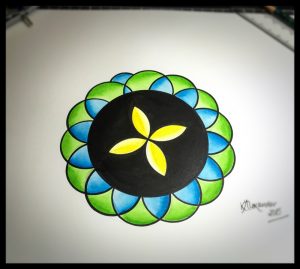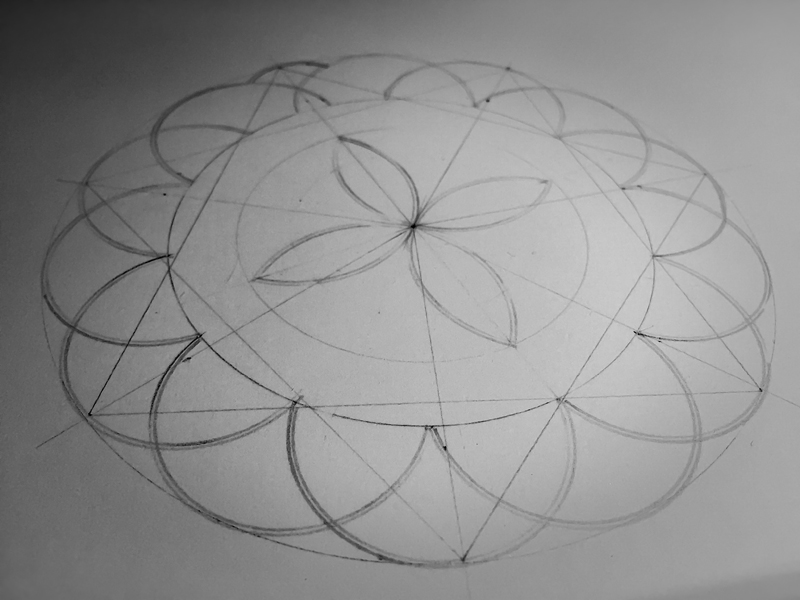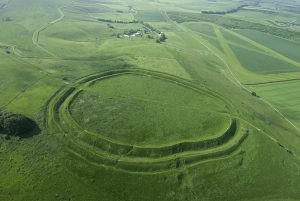The first crop circle of the 2015 season (in the UK), was reported on the 9th of April, and was at Barbury Castle in Wiltshire. Barbury Castle has long been a regular host to the crop circle phenomenon, with many iconic formations appearing in the fields below this great Earth Work.
For those unfamiliar with the Wiltshire landscape, Barbury Castle is a hill fort dating back to around 2500BCE. Hill forts were usually hill top enclosures which would be occupied and the land below them farmed. The elevation in the landscape provided security in perilous times. Barbury was also occupied once again during the Roman era, only going to show what a safe location for settlement it was. The UK countryside is graced with many hill forts of this kind. Close by is Liddington Castle, another hill fort also synonymous with the crop circles. The famous Barbury Castle crop circle of 1991, the Menorah of 1999 & the Pi formation of 2008 are just a few of the many wonders that have appeared in the fields there.
The formation was a 60-70ft ring in a field of immature oilseed rape (canola), close to where the 2008 pi formation appeared. The ring had a satellite circle on it and one appendage coming from it ending on another small circle. As researcher Michael Glickman has already written an interesting blog about this circle, I’m going to refer you to that blog to find out more about the Barbury Castle crop circle.
The second circle of the season was reported at Macmillan Way, near Tarlton in Gloucestershire on the 19th of April. This time the circle was in a field of very immature barley. It’s unusual to have formations in such immature crop. Generally the crop circle makers exhibit a respect for life and wait for the crops to at least mature. This circle was however very small, I estimate it to be no more that 40-50ft. The impression it made in such short plants was very faint indeed, and it was difficult to tell from the available photos the precise design. However, I was able to make a sketch that was as near to the original as I could get from the available information.
Firstly, the formation appeared to be a flattened circle in the centre within which were four standing vesica shapes. Then around the perimeter of this circle were thirteen interlocking rings. These rings did not however meet up perfectly, and as you can see from the diagrams a fourteenth partial circle was added to render the image more complete and aesthetically satisfactory.
It would be all to easy to see this arrangements of rings as an error and that is certainly one interpretation. However, the crop circle subject is usually never that straight forward, and often details such as this can have symbolic import.
As thirteen is the number of transformation, the emergence of a nascent fourteenth circle, might be symbolic. Thirteen is a number we have seen much of in the past few years, with many intuiting that it may be symbolic of paradigm change. If this were to be true, then perhaps this little circle may indicate an emergence from times of transition into a new era? Moving from transformation (13) into new waters (14). It’s a thought to keep on the back burner as the season progresses.

Painting of the circle near Tarlton complete. It threw up an interesting blend of numbers to contemplate.
Finally, I did find an interesting piece of esoteric geometry in my drawing. Bearing in mind I cannot claim it to be 100% accurate, this is open to question. But I did find a (fat) seven-pointed star proportioning the inner circle and the size of the thirteen rings. You can see I have drawn it in to the pencil sketch at the top of the page. In classical geometry there are two seven pointed stars, one fat, one thin. The fat star connects every third point and the thin one connects every fourth point. For those of you unfamiliar with this concept, while circles undoubtedly have an exoteric geometry (the geometry we all see in the field), sometimes, some circles have an esoteric (hidden) geometry, which underpins the proportions of the design – in this case a fat seven pointed star. Some circles have hidden phi proportions, pentagrams or other shapes. This is a deeply fascinating area of crop circle geometry. Needless to say, this can add further depth to any symbolic interpretation. According to antiquarian and geometer extraordinaire John Michell, seven is the number of “Spirit, revelation, the eternal feminine and what lies beyond the veil”. It is certainly connected with the ephemeral; notes in the musical scale, the colours in the light spectrum etc. Seven is known as the virgin number too, as it does not merge well with others – it stands alone – virginal. The overwhelming interpretation of this aloneness is of a spiritual nature. Like the Virgin Mary, who according to catholic tradition, was herself born of a Virgin, begot the Son of God as a Virgin and ascended directly to heaven without suffering death or decay, this untouchable, pure spirituality often seems to be echoed in the crop circles themselves. Both are deeply mysterious and spiritual in some ineffable, untouchable way.
If nothing else, the circle near Tarlton provoked some deep thinking and an interesting blend of numbers to contemplate. Will these numbers be echoed and explored through the 2015 season? Only time will tell…
Karen Alexander




we know that the crop circles are not human made and get excited every time we see a new one, thank you
Hi Maryann
Pleased to know that the crop circles generate some excitement for you.
Its always exciting when we fly and photograph a new crop circle.
Best wishes
Steve & Karen
I have heard that certain people feel better or find cures in recently formed crop circles…..I would like to try this
There have many been reports from people who have said their illnesses have improved after visiting a circle. However, these are largely anecdotal and there isn’t any recognised scientific basis for claims of healing. I’m not doubting what people report, but I would hate to say to you that you would be healed of an illness simply by visiting a circle. By all means visit the circles, but do it because you want to visit the circles, rather than coming for a cure. Best Wishes Karen & Steve
the designs seem to be connected to the dodecagon, check out images.